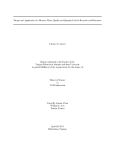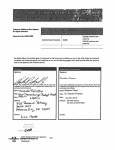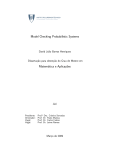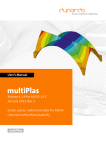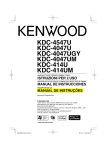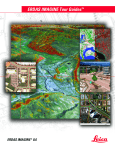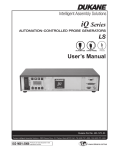Download Special report 16 - Digital Conservancy
Transcript
A PROGRAM TO EXCHANGE ERDAS
AND EPPL7 DATA FILES
"'•'
I
.
''
'
I
WATER RESOURCES RESEARCH CENTER
UNIVERSITY OF MINNESOTA
ST. PAUL, MN 55108
Special Repor~ No. 16
June 1987
ACKNOWLEDGEMENTS
This report is part of a larger project supported by funds from the
Legislative Commission on Minnesota Resources and supervised under contract
with the Department of Natural Resources.
We gratefully acknowledge several individuals for their contribution to the
development of this computer program. Dwight Brown, Phil Gersmehl, and Dick
Skaggs of the Geography Department supervised the development of this program
and provided access to the necessary computer equipment. Les Maki, Paul Tessar,
-Pete Olson, and Steve Anderson of the Minnesota Planning Information Center
provided up-to-date copies of the EPPL 7 program and documentation for our
scrutiny, and managed to keep an open ear to our comments. Bruce Rado, and
countless other staff members at ERDAS, kept our hardware and their software in
operation through the years, beginning with an early-model ERDAS 400, which the
Geography Department only recently retired, and currently with our IBM AT. Phil
Voxland of the University's Social Sciences Research Facilities Center answered a
number of picky technical questions regarding FORTRAN on an IBM AT. Jim
Young of the Geography Department was good natured about testing our software
and documentation.
IBM, PC, XT, AT, PC-DOS, CGA, EGA, and PGA are repterec:l traclemarlu and producta of the
, International Buaineu Machinea Corporation. MS il a repterec:l trademark, MS-DOS il a reciltered product, and
FORTR.AN-71 Veraion S.Sl il a copJricM product of MicroaoR Corporation. ERDAS il a recilterec:l trademark
and copJricht product of ERDAS, Inc., Atlanta, Georcla. EPPL7 il a copJricht computer procram of the
Plannlnc Information Center, Minneaota State Planninc Acency. DEC and VAX are recllterec:l trademarka and
product• of the Dicital Equipment Corporation. SideKick il a trademark and regiltered product of Borland
International. Landlat ret.n to a aeriea of aatelUtea oricinally launched by the U.S. Geolocical Survey and the
National Aeronautica and Space Aclminiltrat;ion. Current Landlat aatelUtea are under operation of EOSAT, Inc.,
Lanham; Maryland.
Water Resources Research Center
The Graduate School
The University of Minnesota
PATRICK L. BREZONIK, Director
ELIZABETH ESPOINTOUR, Secretary
This is number sixteen in the WRRC Special Report series. The Center also
publishes technical reports and a newsletter. A publication list is available from
the WRRC.
The University of Minnesota is committed to the policy that all persons shall have
equal access to its programs, facilities, and employment without regard to race,
religion, color, sex, national origin, handicap, age, or veteran status.
,.
A PROGRAM TO EXCHANGE ERDAS
AND EPPL 7 DATA FILES
Specia I Report 16
Kevin L. Anderson
Bradley W. Scheer
GEOGRAPHY DEPARTMENT
UNIVERSITY OF MINNESOTA
WATER RESOURCES RESEARCH CENTER
UNIVERSITY OF MINNESOTA
ST. PAUL, MN 55108
JUNE 1987
A PROGRAM TO EXCHANGE ERDAS AND EPPL7 DATA FILES
Kevin L. Anderson
Bradley W. Scheer
ABSTRACT
This report is the documentation and user manual for a FORTRAN-77
computer program to convert geographic information system (GIS) files and
satellite data between ERDAS image analysis system and EPPL 7 GIS file formats.
This program expands the data-capture ability of the EPPL 7 GIS and allows users
to take advantage of the analytical techniques of both systems when using an IBM
PC-AT or compatible computer equipped with an Enhanced or Professional
Graphics Adapter and appropriate ERDAS hardware and software.
Hardware/Software Requirements.
IBM PC/XT I AT or compatible computer
256-Kilobytes memory
monochrome or color display adapter
two floppy-disk drives or combination of a hard
and floppy disk drive
PC/MS-DOS 3.10 or later
Disclaimer. The authors of this program, and the names of individuals
listed as contact persons at the University of Minnesota, are not responsible for the
consequences or damages that may result from an incorrect or unsupervised use of
this program, including the inadvertent modification or loss of data or the loss of
entire files. We are also not responsible for any misuse or misinterpretation of the
data used with this program. We cannot guarantee the program or documentation
to be entirely error-free. The program was tested on an IBM AT with 512
kilobytes of memory, IBM Monochrome and Professional Graphics Displays, and no
memory-resident programs (such as SideKick, etc.); we cannot guarantee that your
particular hardware/software configuration will not interfere with the proper
operation of the software. The current version of the EPPL/ERDAS conversion
program described in this document does not provide for backup copies or
protection of existing files that are overwritten by an operation of this program.
The user of this program is expected to provide the necessary file protection and
backup of their data.
-------A PROGRAM TO EXCHANGE ERDAS AND EPPL7 DATA FILES
Kevin L. Anderson
Bradley W. Scheer
INTRODUCTION
This utility program converts data files between the ERDAS and EPPL 7
geographic information systems (GIS). The particular advantages of both cellbased systems can be fully exploited with this package. The program is menudriven, allowing the user to easily step through the conversion process. Data
packed in 4- and 8-bit ERDAS formats are currently supported, as well as files
with up to 10,000 columns of data in each row. (Due to their incompatible nature,
16-bit ERDAS data files cannot be converted to EPPL 7 format with this program.)
In addition, single bands of a Landsat satellite image in the ERDAS system can be
converted to an equivalent EPPL 7 format. All color and legend information
associated with a data file is transfered between the two systems. Written in
Microsoft Fortran-77, the program is easily adaptable to newer version of data files
in either GIS.
The ERDAS and EPPL 7 Systems
The ERDAS (Earth Resources Data Analysis System) package combines the
processing of satellite imagery with the analytic tools of a geographic information
system. This cell-based system commonly handles classified data with categories
numbered from 0 to 255 (where 0 represents "offsite" or "background" areas).
Software procedures allow the user to rectify a satellite image to a map base,
collect "spectral signatures" of land cover identified on the image, create a
classified GIS map of the satellite image, overlay additional GIS files for
identification of spatially-congruent activities (e.g. forested land cover on sandy
soils with 5 to 10 percent slopes that are owned by the Federal Government), select
smaller "windows" from a larger file for subsequent analysis, change the cell-size
(resolution) of the data to match other GIS maps, and print the files as maps for
analysis or publication. Although the software runs on a standard IBM PC-AT
computer, additional hardware of a specialized nature, including a math
coprocessor, high-resolution monitor, image-processing board, nine-track magnetic
tape drive, and color printer, is also necessary. (Versions of the ERDAS software
also exist for DEC VAX, Prime, and Data General computers, which we currently
do not support with this conversion program.)
The EPPL 7 (Environmental Planning and Programming Language, Version
7) software provides a complete set of procedures for a cell-based GIS. The
package requires only a "vanilla" IBM PC (two-floppy disk drives, color display
adapter, and 256 kilobytes of memory).
Although the standard color display
adapter (CGA) with four colors is supported, an enhanced color adapter (EGA)
with 16 simultaneous colors out of 64 or a professional color adapter (PGA) with
256 simultaneous colors out of 4096 is recommended. Categories in an EPPL 7 file
are numbered from 0 to 255. Separate text files contain the legend or color
sequence (in intensity of red, blue, and green colors) for each class of a map.
II
WRRC, U. OF Minn. Special Report Sixteen
- 4 -
SOFTWARE INSTALLATION
The distribution disk for the conversion program contains a single program,
Although the program will execute from a floppy-disk, the
EPPERD.EXE.
software operates faster if installed on a hard disk. We recommend installation of
the EPPERD program on the ERDAS computer, since that system requires a hard
disk for its operation.
We grant permission for additional copies of this program to
reside on each computer that contains the EPPL7 package, if those
machines are separate from the computer that contain the ERDAS
software.
If a floppy disk must be used, install the program on a disk that has been
formatted to contain a copy of the operating system (using the DOS FORMAT
command with the /S option). Because of the potentially large size of many GIS or
Landsat files, we do not recommend this type of operation, unless high-density (720
Kb, 1.2 Mb, or 1.4 Mb) floppy disks are available.
Installation on the ERDAS computer
With the current implementation of the ERDAS software (Revision 7.2), the
EPPERD program should be installed in the same subdirectory as the ERDAS
programs. On our IBM AT, that subdirectory is C:\ERDAS72\PROGS. To copy the
EPPERD program to this subdirectory, use the DOS 'COPY' command as follows:
COPY A:EPPERD.EXE C:\ERDAS72\PROGS /V
The EPPERD program can be executed from the ERDAS menu system by typing its
name in response to the 'ERD>' prompt.
Installation on the EPPL7 computer
Please ignore the following if the EPPL7 and ERDAS computers are the same.
The EPPERD program should be installed on the same subdirectory as the
EPPL 7 program. On our particular IBM AT, this subdirectory is C:\EPPL 7. To
copy the EPPERD program to this subdirectory, use the DOS 'COPY' command as
follows:
COPY A:EPPERD.EXE C:\EPPL 7 /V
Substitute your particular subdirectory name for the C:\EPPL 7 used in this
example. The EPPERD program can now be executed outside the EPPL 7 program
in response to the DOS prompt.
ERDAS/ EPPL7 Conversion Program
- 5 -
THE CONVERSION PROGRAM
Operation of the EPPERD conversion program is simple. In the examples
that follow, Bold statements represent messages or requests presented by the
program, and reply are responses provided by the user. The ERDAS GIS file,
SOILS.GIS, is used in this demonstration. That file uses 13 categories (including
the offsite category) to map soils of the Mobile Bay area by their textural class:
TABLE 1
CATEGORIES IN THE ERDAS 'SOILS' DEMONSTRATION FILE
(LEVEL 0 IS THE OFFSITE CATEGORY)
Legend
]
2
3
4
5
6
7
8
9
10
] ]
12
Gravelly-Loamy
Fine Sandy-Laomy
Coarse Sandy-Loamy
Coarse Loamy
Clayey
Clayey-Mixed
Loamy
Fine Loamy
Silt-Loamy
Silt-Sandy
Sandy
Mobile Bay & Gulf of Mexico
The 'SOILS.GIS' file is part of the standard ERDAS installation package and not
included with the EPPERD program. In this documentation, we also refer to a
Landsat image of the Mobile Bay area, MOBBA Y.LAN, which is included with the
ERDAS system, as an example of a satellite image that might be used with a GIS.
To help the user understand the conversion process, the following
description of program options has been divided by task.
We will begin by
describing how to start the program and receive the main menu. After that, each
menu option will be discussed separately. The conversion of ERDAS GIS and
Landsat image files to the EPPL7 will be discussed first, followed by the
conversion of data files from EPPL 7 to the ERDAS system. Although we use the
same 'SOILS' file to demonstrate both options, the user will rarely need to convert a
file from one system to another and then back again.
WRRC, U. OF Minn. Special Report Sixteen
-6-
STARTING THE PROGRAM
The conversion utility is started by simply typing:
epperd
The conversion program can be called from the ERDAS menu driver as long as the
program resides in the standard ERDAS program subdirectory (\ERDAS72\PROGS)
or in a subdirectory assigned by the DOS PATH command. The user needs only to
type EPPERD in response to the ERD> prompt. When used on a computer with
EPPL 7, the conversion program executes outside the EPPL 7 package.
When the EPPERD program is loaded, the following message appears:
•••••••••••••••••••••••••••••••••••••••••••••••••••••••••••••••
••
••
••
•• EPPL 7/ERDAS Data File Conversion Program ••
••
••
Copyright (C)
••
••
Department or Geography
••
••
University or Minnesota
••
••
- Version 2.33 July, 1987 ••
••
••
•••••••••••••••••••••••••••••••••••••••••••••••••••••••••••••••
thisoption:
message, the program will display its standard menu and
request Following
a conversion
Conversion Type?
1) From ERDAS to EPPL 7
2) From EPPL 7 to ERDAS
3) Exit Program
Enter a 1, 2, or 3
The user must respond with a digit to select the desired conversion option.
If a character other than a I, 2, or 3 is entered, the program will display an error
message for an incorrect option and display the menu a second time. After each
file conversion, the program will once again display this menu.
ERDAS/ EPPL7 Conversion Program
- 7 -
OPTION 1 -- CONVERSION TO EPPL 7
Option 1 on the main menu selects the conversion of an ERDAS GIS or
Landsat file to a comparable EPPL 7 file:
Enter a 1, 2, or 3
1
The program will now prompt the user for names of the data files to
convert:
Enter a file name for an ERDAS (.GIS) file.
soils
Enter a file name for an EPPL 7 (.EPP) file.
soils
The two filenames do not necessarily have to be the same, although
similarity can help someone trying to trace the origin of a file. The user also does
not need to enter an extension for each file. The program automatically assumes a
'.GIS' extension for an ERDAS GIS file and a '.EPP' extension for an EPPL 7 file.
If you wish to convert a single band of a satellite image on the ERDAS system,
you must enter both the file name and the '.LAN' file extension (e.g. mobbay.lan)
for the ERDAS file.
If either file cannot be found, the program will request a different
filename from the user. Make sure that the proper disk drive is specified for each
file. (You do not need to enter the disk drive letter or subdirectory designation if
they .are the same as the default drive specified in the DOS prompt.)
After the files have been located, the program will read the header record
of the ERDAS file to obtain the number of lines and columns, packing format, and
the number of bands in the data file. If more than one band is present in the file
(i.e. the ERDAS file represents a Landsat image), the program will request a
number for the band to convert:
This ERDAS file contains 4 bands.
Which Band do you want to Copy?
The user should select a band for the conversion. For example:
Which Band do you want to Copy?
3
will convert the third image band (out of four). When a Landsat file is converted
to an EPPL7 GIS file, each class in the GIS file represents an intensity value from
0 to 127.
WRRC, U. OF Minn. Special Report Sixteen
- 8-
The number of rows and columns in the file will be displayed, followed by
the current line being converted by the program.
For the ERDAS 'SOILS'
demonstration file, this message will read:
ERDAS File has
500 rows and
417 columns
... Copying ERDAS file to EPPL 7 file
... Processing Row
1
The ' ... Processing Row' message is updated with each new row that is converted to
EPPL 7 format. It is not uncommon for data files to take several minutes to be
converted. All ERDAS files converted to the EPPL 7 will have Class 0 declared as
the "offsite" or "background" (the normal value on the ERDAS system).
When the conversion of the data file is complete, the display will read:
ERDAS File has
500 rows and
417 columns
... Copying ERDAS file to EPPL 7 file
... Processing Row 500
..• Done!
The user now has the opportunity to convert the ERDAS Trailer file
('.TRL') to its equivalent EPPL 7 Color Table ('.CLR') and Legend ('.LEG') files:
Do you want to convert the ERDAS Trailer (.TRL) file? (Y or N)
You should select this option only if an ERDAS GIS file was converted by
this program; ERDAS Landsat files do not have a Trailer file. The program
automatically assumes that the Trailer file is to be created using the same file
name as the ERDAS data file (e.g. 'SOILS.TRL' for the 'SOILS.GIS' file). The
EPPL 7 Color Table and Legend files are assumed to have the same name as the
'.EPP' file, except for a change in extensions.
If the user responds with 'yes' (Y), the program creates the EPPL 7 files:
Do you want to convert the ERDAS Trailer (.TRL) file? (Y or N)
y
..• Reading Histogram
••• Creating LEGEND file
..• Creating COLOR TABLE file
After the successful conversion of the ERDAS Trailer File, the program returns to
the main menu. If the user responds to the request with 'no' (N), the program goes
immediately back to the main menu.
ERDAS/EPPL7 Conversion Program
- 9-
OPTION 2 -- CONVERSION TO ERDAS
Option 2 on the main menu selects the conversion of an EPPL 7 GIS file to
the ERDAS system:
Enter a 1, 2, or 3
2
The program prompts the user for the names of the data files to convert:
Enter a file name for an EPPL 7 (.EPP) file.
soils
Enter a file name for an ERDAS (.GIS) file.
soils
The two filenames do not necessarily have to be the same, although
similarity can help someone trying to trace the origin of a file. The user also does
not need to enter an extension for each file. The program automatically assumes a
'.EPP' extension for an EPPL 7 file and a '.GIS' extension for an ERDAS GIS file.
If you wish to convert an EPPL 7 file into a satellite image file with one band on
the ERDAS system, you must enter both the file name and the '.LAN' file extension
(e.g. mobbay.lan) for the ERDAS file. (Class values in the EPPL 7 file must also
represent intensity values between 0 and 127 to work properly as a Landsat file.)
If either file cannot be found, the program will request a different
filename from the user. Make sure that the proper disk drive is specified for each
file. (You do not need to enter the disk drive letter or subdirectory designation if
it is the same as the default drive specified in the DOS prompt.)
After the files have been located, the program will read the header record
of the EPPL 7 file to obtain the number of lines and columns. These values are
displayed for the users benefit. For the 'SOILS' demonstration file, this message
will read:
EPPL 7 File has
500 rows and
417 columns
To properly convert an EPPL 7 file to the ERDAS system, the EPPERD
program must know the value for the highest category in the GIS file. This value
controls the form of data packing used in the ERDAS file, plus is stored as part of
the ERDAS header record. The user must enter the value in response to the
following question:
What is the HIGHEST CLASS number in the file? [0 •• 255)
This number is usually determined using the 'COUNT' command of the EPPL 7
-
--
- - -
---
-----
-
-
II
WRRC, U. OF Minn. Special Report Sixteen
- 10 -
program. For the 'SOILS' demonstration file, the highest class number is 12 (see
the list of categories in Table 1):
What is the HIGHEST CLASS number in the file? (0 .. 255)
12
The program will now create an ERDAS file from an EPPL 7 file.
this conversion, the user will be kept informed of the progress:
During
••• Copying EPPL 7 file to ERDAS file
••• Processing Row
1
The •... Processing Row' message will be updated with each new row. It is not
uncommon for data files to take several minutes to be converted. When the
conversion of the data file is complete, the display will read:
ERDAS File has
500 rows and
417 columns
••• Copying EPPL 7 file to ERDAS file
••• Processing Row 500
••• Done!
After this conversion, the user will have the opportunity to create an
ERDAS Trailer file ('.TRL') from its equivalent EPPL7 Color Table ('.CLR') and
Legend ('.LEG') files:
Do you want to build the ERDAS Trailer (.TRL) file? (Y or N)
If the user responds with 'yes' (Y), the program will create the ERDAS
Trailer file. The program assumes that the Trailer file should be created using the
same file name as the ERDAS data file (e.g. 'SOILS.TRL' for the 'SOILS.GIS'). The
EPPL7 Color Table and Legend files are assumed to have the same name as the
'.EPP' data file.
Do you want to build the ERDAS Trailer (.TRL) file? (Y or N)
y
••• Writing COLOR TABLE to the Trailer File
••• Writing HISTOGRAM to the Trailer File
••• Writing LEGEND to the Trailer File
Following the successful creation of an ERDAS Trailer file, the program returns to
the main menu. If the user responds to the request with 'no' (N), the program goes
immediately back to the main menu.
ERDAS/ EPPL7 Conversion Program
- II -
An ERDAS Trailer file can still be created without the existence of either
or both of the EPPL 7 Color Table and Legend files. (Not all EPPL 7 files are
required to have legend or color information.) If either file does not exist, the
ERDAS Trailer file is created using fabricated values (all black colors or blank
legend names). A frequency count of class values is still written to the Trailer
file, regardless of the existence of either EPPL 7 file. For example, if neither file
exists, the following messages will be displayed:
.•• Writing COLOR TABLE to the Trailer File
••• Oops! Can't find Eppl7 Color File •••
... Writing "Dummy" Version to the Trailer File
... Writing HISTOGRAM to the Trailer File
... Writing LEGEND to the Trailer File
••• Oops! Can't find Eppl7 Legend File •••
... Writing "Dummy" Version to the Trailer File
A missing file message may only indicate that the Color Table or Legend file exist
on a different floppy disk or subdirectory than the GIS files. If this is the case,
the currrent version of the EPPERD program requires the user to rerun the entire
conversion process after making the color table or legend files available. The
EPPERD program does not have the option to convert or create just the trailer file.
LEAVING THE PROGRAM
Option 3 of the main menu is used to exit the program:
Conversion Type?
1) From ERDAS to EPPL 7
2) From EPPL 7 to ERDAS
3) Exit Program
Enter a 1, 2, or 3
3
The program returns the user to the default DOS prompt (e.g. C:>)
ERROR MESSAGES
This EPPERD program has been designed to catch errors without forcing a
premature end of the program. For user responses (e.g. conversion option, file
names, band numbers, yes/no questions, etc.), an incorrect response usually leads to
an error message, followed by a repeat of the question. Trouble encountered
during the processing of files (e.g. read errors, incorrect data formats, etc.) usually
results in cancellation of the requested conversion.
WRRC. U. OF Minn. Special Report Sixteen
- 12 -
Problems with the EPPERD file conversion program should be reported to
the contact persons listed below. Please include a printed copy of the screen
display, plus a description of your data files and equipment, with your
correspondence to help us diagnose the problem.
REFERENCES
The following persons may be contacted for information on the program
and to report specific problems with the software:
Dr. Dwight Brown or
Dr. Philip Gersmehl
Department of Geography
University of Minnesota--Twin Cities
414 Social Science Building
267-19th Avenue South
Minneapolis, Minnesota 55455
Please refer to Special Report No. 16 in your correspondence.
Disclaimer. The authors of this program, and the names of individuals
listed as contact persons at the University of Minnesota, are not responsible for the
consequences or damages that may result from an incorrect or unsupervised use of
this program, including the inadvertent modification or loss of data or the loss of
entire files. We are also not responsible for any misuse or misinterpretation of the
data used with this program. We cannot guarantee the program or documentation
to be entirely error-free. The program was tested on an IBM AT with 512
kilobytes of memory, IBM Monochrome and Professional Graphics Displays, and no
memory-resident programs (such as SideKick, etc.); we cannot guarantee that your
particular hardware/software configuration will not interfere with the proper
_operation of the software. The current version of the EPPL/ERDAS conversion
program described in this document does not provide for backup copies or
protection of existing files that are overwritten by an operation of this program.
The user of this program is expected to provide the necessary file protection and
backup of their data.














